Antique McCoy Pottery were the gems of homeowners in the early 1900s to late 1960s. They were simple yet unique decorative pieces with striking shapes, patterns and endearing colors. Their affordability for all and sundry sets them apart in pottery.
These pieces of excellent pottery can go from as little as $5 to a whopping $3000 on various online sites like Etsy, eBay and RubyLane.
Keep an open mind, fix your gaze, and walk hand in hand with us as we take you on a whirlwind journey into Antique McCoy Pottery, help you identify them and understand their true value.
Table of Contents
Brief History of McCoy Pottery
The McCoy Pottery company has quite an interesting journey. This American company was found by William Nelson McCoy in Roseville Ohio, 1848.
The choice of Roseville as the designated area wasn’t farfetched- the area had a large quantity of clay. It was given to them at zero cost due to the benefits the area would get from the company (Employment and Revenue).
Nelson McCoy initially established the company as the Nelson McCoy Sanitary and Stoneware Company, which produced utility stoneware items but his journey was cut short as he fell sick and died in 1914, after which his son, Nelson McCoy Jr, ran the company.
In 1918, the McCoy clan sold their interest in the pottery company and by 1919, eleven other companies joined forces to form the American Clay Products Company, with its headquarters in Zanesville, Ohio.
George Bush remained the highest stockholder in the ACPC. He retained the McCoy title until 1925, after which the company changed their name to the Brush Pottery Company.
Following the decline in the purchase of utilitarian earthenware, ACPC liquidated, and each partner company parted ways and became a single entity.
By 1929, they changed their name to Nelson McCoy Sanitary Stoneware Company, targeted at serving their new audience’s needs.
This didn’t last long as the food and sanitary ware market declined. A new thirst for decorative wares took over, which led the company to change its name to Nelson McCoy Pottery Company.
However, in 1933, the company redirected its production system and went into art pottery. It began making decorative items and less utilitarian objects. Their decorative pieces, cookie jars, and vases were popular before and after World War ii.
They changed administrative powers through the years, expanded their territory and by 1990, the end came for McCoy Pottery Company’s existence.
McCoy Pottery Line
McCoy pottery lines span across purposes and aesthetics. From fun but very handsy items to more utilitarian wares. Their products duly reflected the turns of time, techniques and trends of fashion and society at that period.
The company made each line of pottery in myriads of colors and glazes; these hues include white, yellow, brown, coral, green and other shades; some also came in multiple colors. Some very popular McCoy pottery lines include;
Blossom Time
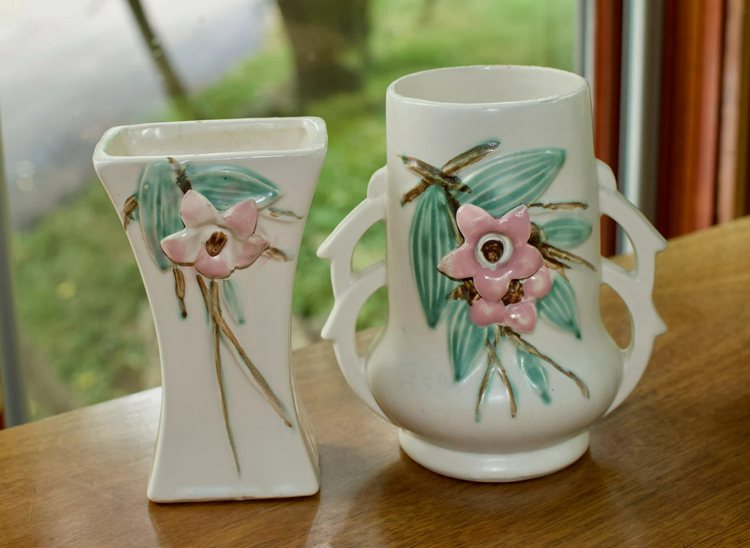
This comprised heavy floral patterns, multi colors and beautiful over-the-top bright hues that dominated the scene from the mid-1940s. These pieces are highly collectible and modern, even though they’re of antique descent.
Strawberry Country
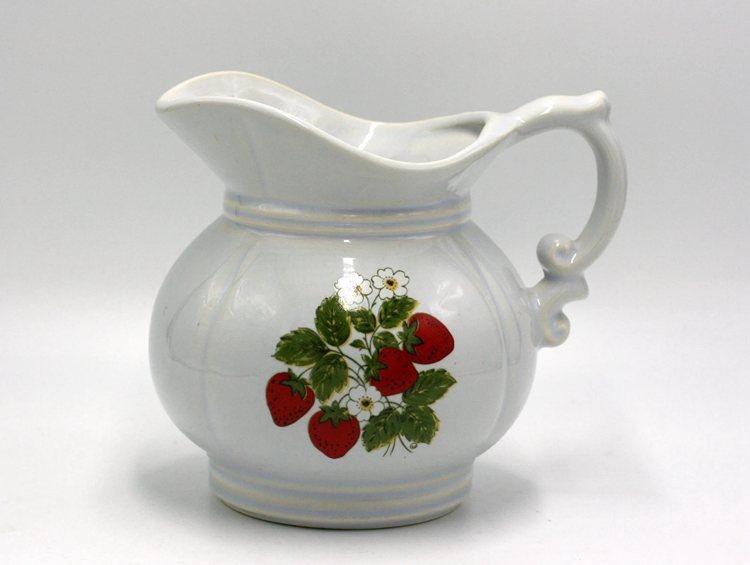
You may call them the late bloomers as they mostly debuted towards the end of McCoy company’s journey. Simple, soft and fiery, the strawberry country did not stray too far from its name as it featured strawberries on a bright white glazed surface.
3. Onyx
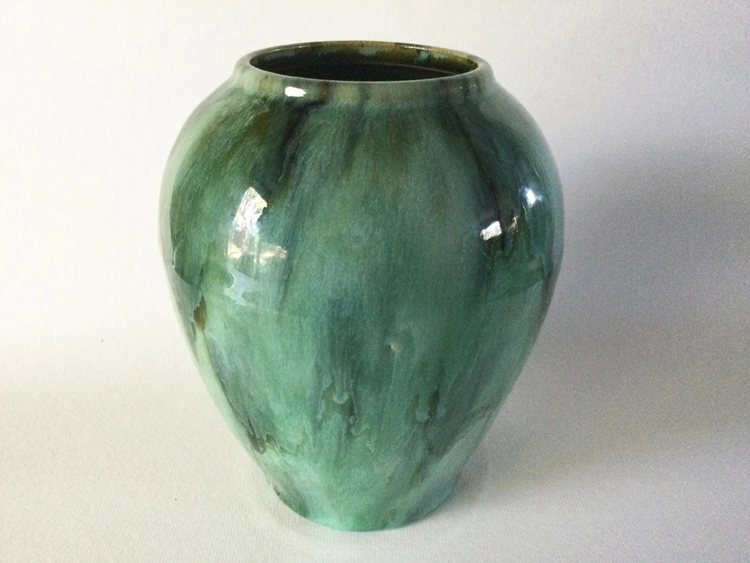
The Onyx line has a beautiful spiral glaze resembling a stone.
8 Ways to Identify Authentic McCoy Pottery
This section will help you finally learn how to identify McCoy products like the back of your hand. Just stick to the instructions, and you’re good to go.
Join a Club
The McCoy Pottery Collectors Society is a group of collectors with vast knowledge of McCoy pieces. They can help you with all the necessary information, from their history to their line name, types and styles. Here’s a video of the society’s annual reunion.
Examine the Colors
Nelson McCoy’s pottery pieces have the widest range of colors from pastel green, yellow, blue and light brown, including hand-painted red berries with green leaves to the 1951 pieces, which had green, burgundy plus green and yellow with a bird.
The 1957 sunburst gold piece combined matte and glossy 24k gold hue, while the Grecian piece had ivory shades with green adornment and 24k gold networking.
Appraise Your Piece
Appraisers do an excellent job by helping you clear up the gray areas and answer any questions you may have on McCoy pottery pieces. Appraisal services are not free but super affordable, so you don’t have to worry about breaking the bank to get things in order.
Consult a Catalog
To aid easy identification, buyers, collectors and art enthusiasts have gathered facts and pictures that can point out fakes while providing information on designs and rare styles. Check out some resources below
The company produced a catalog in 1904, which identified the four pottery lines made at the time. Some items were often marked with the line’s name to which they belonged. These names included Carnelian, Rosewood, Light Blends and Rainbow.
Study the Patterns
McCoy has made numerous patterns over the years, and it can be quite tasking to easily identify them even with prior knowledge (we can imagine how a greenhorn would feel). Well, there’s a way out.
You can visit the McCoy Pottery Pattern index to help you identify these McCoy pieces.
The Nelson McCoy patterns had some of the widest range of varieties, from hobnails to flower holders to flower bowls, ripple ware, vases, fruit planters and brocades.
Look for Marks
The McCoy pottery company inscribed McCoy marks on their products, which is one way to determine your pottery’s authenticity. Original McCoy pottery pieces have the “McCoy Made in USA” inscribed.
You’ll likely find only “McCoy” stamped on the earthenware for the fakes. For example, the McCoy Squirrel Cookie Jar has “McCoy” and “USA.’
In the early days of the company, it placed the number 4 inside a shield set inside a circle; after a while, it changed to the number 9 sitting inside a circle placed inside a shield. However, not all original Antique McCoy pieces are marked and vice versa.
It’s in the Details
Legit McCoy pieces have heavy detailing that show almost perfect craftsmanship and flawless artistry. They have unique identification marks, vibrant paint colors and sharp glazes. You’d notice ordinary designs for the fakes, little to no paintwork, and tacky finishing.
Be on the Lookout for Reproductions
If your McCoy pottery is light, too shiny and has an average to poor finish, you might want to give the fact that it may be a reproduced piece a thought. Reproductions even go as far as having marks on them to confuse buyers.
Make sure you confirm the authenticity before purchasing.
Check out this video for a more detailed analysis.
How to Determine the Value of McCoy Pottery
McCoy pottery stands tall among the most valuable household and decorative stoneware antiques the world has seen. Every collector is hot on their heels.
Find out the Age of the Item
For your McCoy pottery to hold a lot of value, you must check if it’s as old as claimed.
The pieces rolled out from the company’s early 1940s to 1950s are valuable and they sell for a higher price than the new pieces. You can spot them by aging signs, wearing out of color and harmless cackling.
Compare Pieces
Head to various online platforms and sales houses and review their sales inventory on previous McCoy pieces. This will help you understand the possible prices each piece sells for and how to ultimately set your price, so you don’t run at a loss.
Explore the Items Rarity
The rarity of your McCoy pottery piece contributes to its perceived market value. For example, the original McCoy monkey head planter designed by chief designer Sidney Cope was estimated to have cost about $400.
The most common McCoy pieces ranged between $25 to $200.
To identify more of Cope’s designs during her time with the company, which spanned from 1933-1966, check underneath the piece for an N and M logo which is also often stylized with “USA” underneath.
Know Your Pottery Piece
You must know the type of McCoy piece you’re dealing with. Prices and value usually differ according to their sizes, purposes and functionality. For example, a McCoy cookie jar may be of more value than a tea cup due to its size and numerous functions.
The Indian cookie jar is also very popular and highly sought after; the McCoy cookie jars existed in other shapes like beehives, fruits, flowers, animals and even clowns. McCoy planters are also a hot commodity.
Find a Catalog
Various price and value catalogs have been compiled online to help you easily determine the value of your Antique McCoy pieces. Check out a few links below.
Examine the Condition of the Item
We encourage keepers and collectors of antique items to always ensure that their antique item is in good shape. If important parts of your McCoy pottery are broken, chipped off, faded or heavily cracked, the value reduces by at least 60%.
Please ensure you always keep your pottery safe, wash them with mild detergent, keep them away from direct sunlight, and wrap them in soft fabric when not in use. It’ll help extend the shelf life.
Consider Market Factors
Demand and supply factors greatly affect an antique piece’s perceived value. So, if an item is heavily demanded, the value will go up regardless of whether it’s a limited-edition piece.
The Different Types of McCoy Pottery Marks
Although not all the pieces were marked, they incised marks on some earthenware decorative pieces. These marks didn’t come until 1929 when the company used a number style for identification.
The Nelson McCoy Pottery Marks
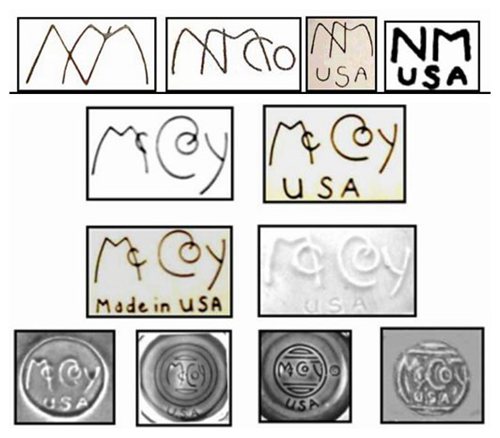
During Sydney Cope’s era in 1934, he introduced the use of NM initials as the logo for McCoy pieces. Although the marks varied greatly in appearance, they still all represented Nelson McCoy. Below are varieties of marks that the company used in Sydney Cope’s era.
Fast forward to the middle of the 1940s, these logos changed from ‘N.M.’, ‘NM USA’, ‘MCP’, ‘NM CO’, ‘McCoy USA’, ‘McCoy MADE IN USA’, McCoy LCC’ ‘N.M.
Made in USA’ to ‘McCoy’ since no other McCoy brother or son was in the pottery business. Soon they devised a way to make the marking more permanent.
The Lancaster Colony Corporation
You may come across ‘LCC’ and ‘LCC USA’ added to the end of the beginning of the ‘McCoy” markings. These pieces were rolled out during the Lancaster Colony Corporation era. ’24K Gold’ stamps also stood out on some pieces.
The LCC purchased McCoy pottery in 1974 and started using the “McCoy” phrase as it was used in the 1940s. They, however, added a twist by putting their initials ‘LCC’ to the marks and the ‘USA’. Check below for marks.

Brown & McCoy Marks
The Brown and McCoy pottery pieces were available from 1872 to 1888 (born from a partnership between James McCoy and his Father-in-law Mr Brown). The pieces comprised vases and jars with a distinct finish from fine clay.
Each piece of Brown & McCoy pottery had a special graving with the words ‘Brown & McCoy’.
Mount Clemens Pottery Company Marks
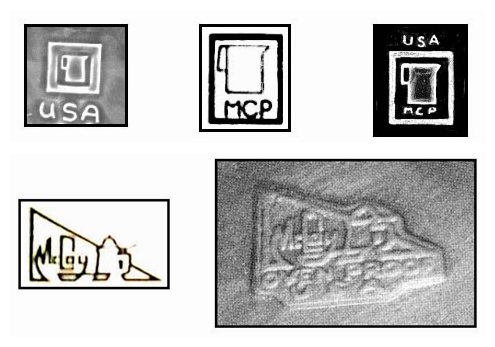
In 1967, Mount Clemens Company bought Nelson McCoy pottery making the latter a subsidiary of the former for about six years. The initial marks the company used didn’t include ‘McCoy’. But by 1968, the mark’s design included the ‘McCoy’ name.
Brush & McCoy Company

The Brush and McCoy era pottery pieces are mostly vases with blended glazes of brown and bright orange colors. They had wide mouthpieces made around 1906 with a fine line that formed unique patterns.
You’d find ‘Brush’ or ‘Brush McCoy’ inscribed on them. Some pieces also had mold numbers alone, while some had mold numbers with USA writing.
George Bush was a major stakeholder in the company. However, the McCoy name was still in active use until 1925, after which the McCoy became known as the Brush Pottery Company.
Nelson McCoy Sanitary Stoneware Company
The Nelson McCoy Sanitary Stoneware Company, established in 1910, didn’t mark their pottery until 1918, as this was the practice.
However, when the alliance between them and the American Clay Production Company crashed, they began marking their wares to establish their identity in the market.
The four marks below are what they used, incising the first three into the underside of the pottery body. The last mark was inscribed with a stamp in blue ink on the side of the pottery piece. The numbers inside the marks mean the size of the pottery you’re holding.

McCoy Pottery Planters
The McCoy company also produced a handful of planters, also known as jardiniere, as part of its inventory. Since most people were fond of growing plants in their homes as parts of decorations, these planters were highly sought after.
The 1940s-era rare McCoy flower planter comes in a very simple unmarked canoe shape. It is a production piece of the McCoy pottery company, according to the McCoy pottery collector’s society. It’s described as a No. K-25 Flower Holder on their catalog.
This planter is 7 inches long and over 2- inches wide. It has a glossy aqua glaze color finish making it one of the hardly found planters from that era.
Here’s another 1930 McCoy planter with a pedestal on sale for $350.
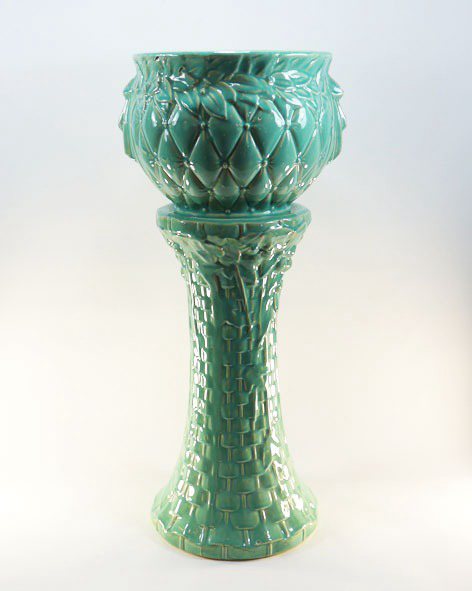
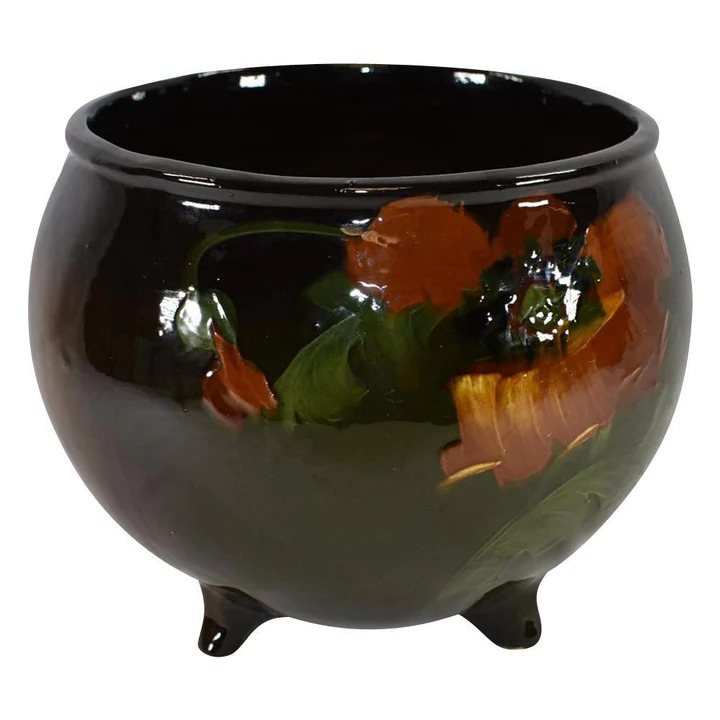
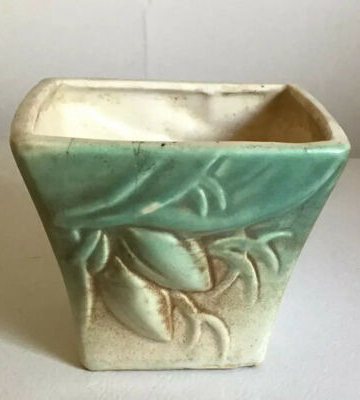
Rare McCoy Pottery and their Value
The rarest McCoy pottery pieces go for as high as $3,500. They can even exceed that depending on how many pieces in that color, pattern or shape exist. Rarity is a big deal in the antique world, and they directly translate to big money.
We’ll be checking out five of the rarest McCoy pottery pieces around.
S/N |
Name |
Date |
Price |
1 |
Davy Crockett Jar |
1950 |
$400 |
2 |
McCoy Ivy Art Pottery Bowl |
1949 |
$98 |
3 |
NM Nelson McCoy Pottery Hobnail and Leaves Flower Pot with Attached Saucer |
1940 |
$95 |
4 |
McCoy Double Handled Strap Turquoise Green Vase |
1940 |
$76 |
5 |
McCoy Hyacinth Flower Vase |
1950 |
$30 |
5. McCoy Hyacinth Flower Vase
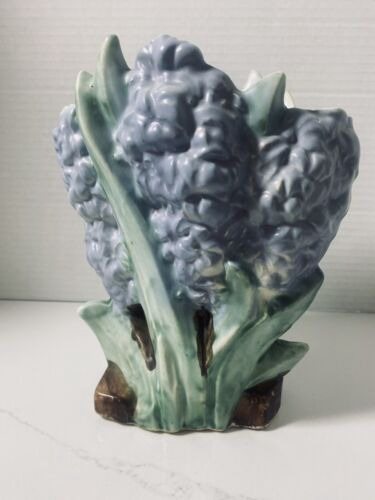
Release Date: 1950
Sold Price: $30
The rare 1950 multicolor hyacinth flower vase was produced by McCoy pottery company from ceramic material. The burst of purple and lavender, which is hand-painted, makes this vase an excellent decorative choice for your table or shelf.
4. McCoy Double Handled Strap Turquoise Green Vase
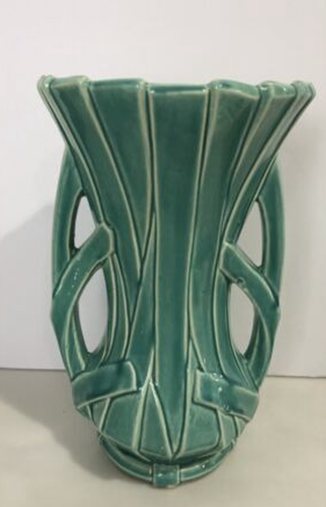
Release Date:1940
Sold Price: $76
This double-handled strap turquoise green vase was made in 1940 by the McCoy pottery company in strap pattern. It weighs 5.8lbs, and the unique color is one of the most endearing features of this piece.
3. NM Nelson McCoy Pottery Hobnail and Leaves Flower Pot with Attached Saucer
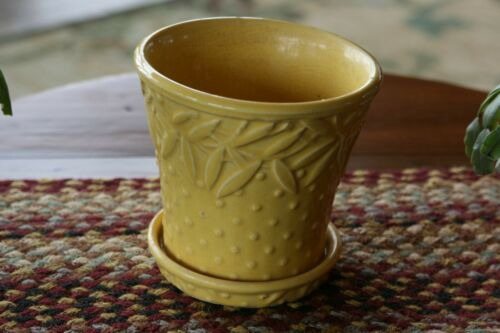
Release Date: 1940
Sold Price: $95
This early 20th-century 5 5/8 tall McCoy clay hobnail flower pot is a rare find, and it comes in a unique shade of yellow with a saucer attached beneath it. The production ran from 1940-1949 and is currently on eBay for $95.
2. McCoy Ivy Art Pottery Bowl
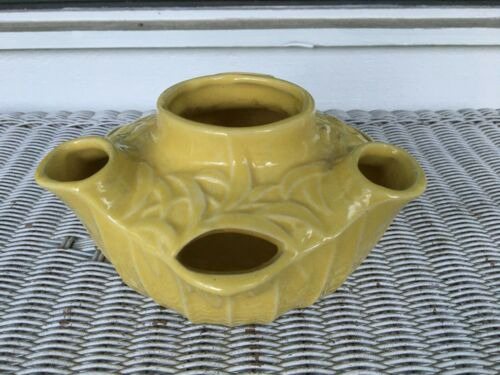
Release Date: 1949
Sold Price: $98
The rare yellow McCoy bowl, which can also double as a planter and hanging basket, was produced in the United States in 1949 during the mid-20th century era, which spanned from 1941-1969. It’s available on eBay for $98.
1. Davy Crockett Cookie Jar
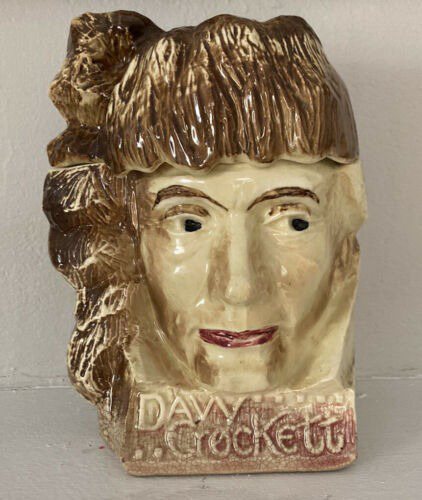
Release Date: 1950
Sold Price: $400
The company made this rare jar in honor of Davy Crockett, a Tennessee-born frontiersman and folk hero. It falls under the cowboy and western theme and is stamped with the ‘USA MCCOY’.
Where to Get McCoy Pottery
From trusted online platforms to the small and big antique stores scattered around town down to the artsy thrift stores and community yard sales. You can find McCoy pottery pieces in the places we’re listing below.
eBay
eBay is a marketplace for all sorts of antique stuff and even new products. The list is endless, and you have dozens of vendors to choose from with prices tailored to your pocket and financial capability. All you have to do is log in, order and input delivery details.
Etsy
Like eBay, Etsy is also a safe place to purchase antique McCoy pottery pieces. The only thing about Etsy is that some of the prices are in Euros. You’d have to mentally convert them if you’re buying from the U.S. or any country that uses a different currency.
Antique Websites
Different websites are specially tailored for the sale of antique objects. You won’t find any other item outside the antique object in this place. You’ll find old McCoy pottery here.
Auction Sites
Some limited-edition McCoy pottery pieces are available on auction sites where you have to bid on them with other interested parties and eventually pay a winning price. Auction sites are reliable because they also offer appraisal services, so you know you’re getting the legit stuff.
Thrift Stores
Thrift stores are littered with pre-owned antique items, which are extremely affordable. You can walk into one and search through piles of pottery items to get yourself a McCoy piece. If you intend to dispose of your collection of McCoy pottery and you’re reading this article, take it as a sign to drop them off at the nearest thrift store. Someone might need them.
Yard Sales
Yard sales are small, organized and have some of the highest numbers of household stuff, including McCoy pottery pieces. Pay attention to the next big yard sale; you might be lucky.
Flea Markets
The antique stuff you’ll find in flea markets are usually very old and might even have cracks, chips and flea bites (if the antique piece is very rare, this shouldn’t entirely affect the quality or value, it’s still a hot item anyway).
Pottery Shops
You’d find old and new pottery pieces in pottery shops scattered around town. One of the advantages of buying antique McCoy pottery pieces in pottery shops is that you get them appraised on the spot and ask the attendant as many questions as you want.
Parting Words
You can bring the old to the new and stay true to the roots by getting yourself a few McCoy pottery pieces to keep as a relic of the past or use them as great decorative pottery for your space. Keep the tips below handy on your quest.
- Never stray far away from your appraiser; in this world of fakes and reproductions, they’re all we could ever ask for.
- The condition of your pottery is a strong determinant of how high your return value would be.
- The older, the better, don’t relent on your search for the oldest of the bunch; you can do this by keeping the address of that flea market, the next yard sale day, in your reminder.

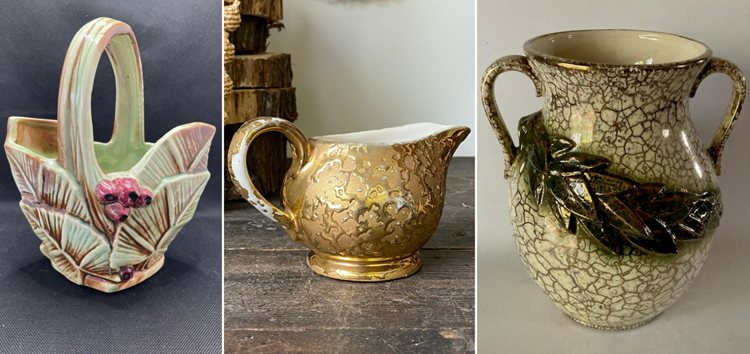
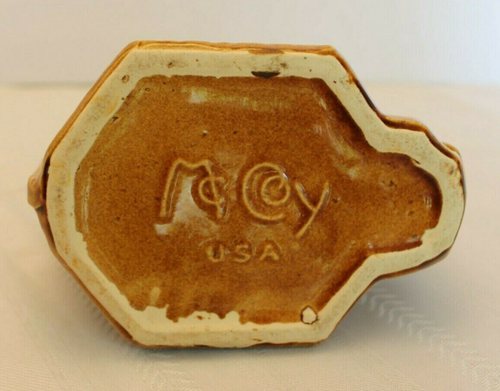
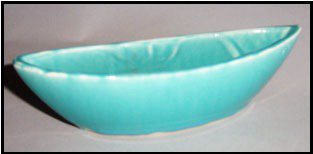




![Where To Sell Antique Furniture In 2022 [Ultimate Guide]](https://www.jacquelinestallone.com/wp-content/uploads/2022/09/Etsy-Your-Place-To-Buy-And-Sell-All-Things-Handmade-600x450.jpg)


